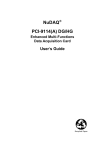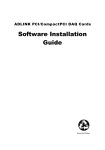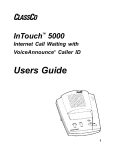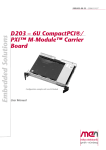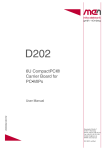Download ADLINK Technology NuDAQ-2500 Series User`s manual
Transcript
NuDAQ® 723X Series 32 Channels Isolated Digital I/O Card User’s Manual Manual Rev. 4.03 Revision Date: January 12, 2006 Part No: 50-11103-2040 Advance Technologies; Automate the World. Copyright 2006 ADLINK TECHNOLOGY INC. All Rights Reserved. The information in this document is subject to change without prior notice in order to improve reliability, design, and function and does not represent a commitment on the part of the manufacturer. In no event will the manufacturer be liable for direct, indirect, special, incidental, or consequential damages arising out of the use or inability to use the product or documentation, even if advised of the possibility of such damages. This document contains proprietary information protected by copyright. All rights are reserved. No part of this manual may be reproduced by any mechanical, electronic, or other means in any form without prior written permission of the manufacturer. Trademarks NuDAQ, NuIPC, DAQBench are registered trademarks of ADLINK TECHNOLOGY INC. Product names mentioned herein are used for identification purposes only and may be trademarks and/or registered trademarks of their respective companies. Getting Service from ADLINK Customer Satisfaction is top priority for ADLINK Technology Inc. Please contact us should you require any service or assistance. ADLINK TECHNOLOGY INC. Web Site: http://www.adlinktech.com Sales & Service: [email protected] TEL: +886-2-82265877 FAX: +886-2-82265717 Address: 9F, No. 166, Jian Yi Road, Chungho City, Taipei, 235 Taiwan Please email or FAX this completed service form for prompt and satisfactory service. Company Information Company/Organization Contact Person E-mail Address Address Country TEL FAX: Web Site Product Information Product Model Environment OS: M/B: Chipset: CPU: BIOS: Please give a detailed description of the problem(s): Table of Contents Table of Contents..................................................................... i List of Tables.......................................................................... iii List of Figures ........................................................................ iv 1 Introduction ........................................................................ 1 1.1 1.2 1.3 1.4 1.5 Features............................................................................... 2 PCI-7230, cPCI-7230, and LPCI-7230 Features ............ 2 PCI-7233/H and Features ............................................... 2 PCI-7234/7234P Features .............................................. 3 Specifications of PCI-7230/cPCI-7230/LPCI-7230 .............. 4 Isolated Digital I/O (DIO) ................................................. 4 General Specifications .................................................... 5 Specifications of PCI-7233/PCI-7233H................................ 5 Isolated Digital Input ....................................................... 5 General Specifications .................................................... 6 Specifications of PCI-7234/7234P ....................................... 7 Isolated Digital Output .................................................... 7 General Specifications .................................................... 7 Software Supporting ............................................................ 8 Programming Library ...................................................... 8 DAQ-LVIEW PnP: LabVIEW® Driver ............................. 9 PCIS-VEE: HP-VEE Driver ............................................. 9 PCIS-OCX: ActiveX Controls .......................................... 9 DASYLab™ PRO .......................................................... 10 PCIS-DDE: DDE Server and InTouch™ ...................... 10 PCIS-ISG: ISaGRAF™ driver ....................................... 10 PCIS-ICL: InControl™ Driver ........................................ 10 PCIS-OPC: OPC Server ............................................... 10 2 Installation ........................................................................ 11 2.1 2.2 2.3 2.4 What You Have.................................................................. 11 Unpacking.......................................................................... 11 Hardware Installation Outline............................................. 12 PCI configuration .......................................................... 12 PCI slot selection .......................................................... 12 Device Installation for Windows Systems .......................... 13 Table of Contents i 2.5 2.6 Connector Pin Assignment ................................................ 14 PCI-7230 Pin Assignment ............................................. 14 cPCI-7230 Pin Assignment ........................................... 16 LPCI-7230 Pin Assignment ........................................... 18 PCI-7233 Pin Assignment ............................................. 20 PCI-7234 Pin Assignment ............................................. 22 PCI-7234P Pin Assignment .......................................... 24 Termination Board Connection .......................................... 25 3 Registers Format .............................................................. 27 3.1 3.2 3.3 3.4 PCI PnP Registers ............................................................. I/O Registers Format.......................................................... Digital Input Register.......................................................... Digital Output Register....................................................... 27 28 29 29 4 Operation Theorem........................................................... 31 4.1 4.2 4.3 Isolated Digital Input Circuits ............................................. 31 Isolated Digital Output Circuits........................................... 32 Change of State Detection................................................. 36 What is COS? ............................................................... 36 Structure of COS detection and Dual Interrupt System 36 COS Detection .............................................................. 38 Warranty Policy ..................................................................... 39 ii Table of Contents List of Tables Table 3-1: I/O Address Map of PCI-7230/cPCI-7230/LPCI-7230 ............................ Table 3-2: I/O Address Map of PCI-7233/PCI-7233H .............. Table 3-3: I/O Address Map of PCI-7234/7234P ..................... Table 3-4: Digital Input Register .............................................. Table 3-5: Digital Output Register ........................................... List of Tables 28 28 28 29 30 iii List of Figures Figure 2-1: PCI-7230 Pin Assignment........................................ Figure 2-2: PCI-7230 Onboard Power and Ground terminal...... Figure 2-3: cPCI-7230 Pin Assignment...................................... Figure 2-4: LPCI-7230 Pin Assignment...................................... Figure 2-5: PCI-7233 Pin Assignment........................................ Figure 2-6: PCI-7233 Onboard Power and Ground terminal...... Figure 2-7: PCI-7234 Pin Assignment........................................ Figure 2-8: PCI-7234 Onboard Power and Ground terminal...... Figure 2-9: PCI-7234P Pin Assignment ..................................... Figure 2-10: PCI-7234P Onboard Power and Ground terminal ... Figure 4-1: Input circuits of 7230 and 7233 series ..................... Figure 4-2: Differential Input circuits of cPCI-7230 .................... Figure 4-3: Isolate output circuits of PCI-7234 (sink current)..... Figure 4-4: Isolate output circuits of PCI-7234P (source current) ....................................................... Figure 4-5: Isolation Output to TTL Input connection................. Figure 4-6: Isolation Output to Isolation Input connection.......... Figure 4-7: Dual Interrupt System of PCI-7233.......................... Figure 4-8: Example of COS detection ...................................... iv 14 15 16 18 20 21 22 23 24 25 31 32 33 33 34 35 37 38 List of Figures 1 Introduction This manual lists and describes the components of the PCI-723X family products, which includes: X PCI-7230: Isolated 16-CH DI and 16-CH DO Card X PCI-7233: Isolated 32-CH DI Card with COS detection X PCI-7233H: Isolated High-speed 32-CH DI Card with COS X PCI-7234: Isolated 32-CH DO Card X PCI-7234P: Isolated 32-CH DO Card (source current) X cPCI-7230: Isolated 16-CH DI and 16-CH DO Module for 3U CompactPCI X LPCI-7230: Isolated 16-CH DI and 16-CH DO Module for low profile PCI These products have high isolation voltage with either 32 DI or 32 DO channels. The high isolation voltage protects the user’s computer against damage caused by accidental contact with high external voltage and eliminates troublesome ground loops. The PCI-7230/cPCI-7230//LPCI-7230 provides 16 isolated inputs and 16 isolated outputs. The PCI-7230/cPCI-7230 isolated I/O channels are isolated to 5000 Vrms, and LPCI-7230 isolated I/O channels are isolated to 2500 Vrms (excluding cables). The PCI-7233 provides 32 isolated digital input channels with COS (change-of-state detection). The high speed version PCI7233H provides 32-CH isolated digital input. The isolation voltage of PCI-7233H is high up to 2,500 Vrms (excluding cables). The PCI-7234/7234P provides 32 isolated digital output (Darlington transistor) channels. The isolation voltage is high up to 5,000 Vrms (excluding cables), both channel-to-channel and channel-tocomputer. (PCI-7234 is sink current DO card, PCI-7234P is source current DO card). The PCI-7230/7233/7234 use ASIC PCI controller to interface the board to the PCI bus. The ASIC fully implement the PCI local bus specification Rev 2.1. All bus relative configurations, such as base memory address and interrupt assignment, are automatically controlled by BIOS software. It does not need any user interaction and pre-study for the configurations. This removes the burden of Introduction 1 searching for a conflict-free configuration, which can be very timeconsuming and difficult with some other bus standards. 1.1 Features PCI-7230, cPCI-7230, and LPCI-7230 Features X 16 isolated Digital Input Channels X 16 isolated Digital Output Channels X High output driving capability X 5000 Vrms high voltage isolation (for PCI-7230 and cPCI7230), 2500 Vrms high voltage isolation (for LPCI-7230) X Interrupt is controlled from external signal X Dual interrupt trigger X 500mA max@ 100% duty, for one of the eight transistor devices ON X Up to 24V voltage protection for isolated input X 37-pin D-type connector (for PCI-7230) X 50-pin SCSI-II type connector (or cPCI-7230 and LPCI7230) PCI-7233/H and Features 2 X 32 Isolated Digital Input Channels X 5000Vrms high voltage isolation (PCI-7233) X Up to 24V voltage protection for isolated input X Interrupt is generated by COS (change-of-state) detection X Dual interrupt trigger X High-speed isolator (1ms) version PCI-7233H available with 2500Vrms isolation voltage X 37-pin D-type connector Introduction PCI-7234/7234P Features X 32 Isolated Digital Output Channels X High output driving capability X 500mA max@ 100% duty, for one of the eight transistor devices ON (PCI-7234: sink current, PCI-7234P: source current) X 5,000Vrms high voltage isolation X 37-pin D-type connector Introduction 3 1.2 Specifications of PCI-7230/cPCI-7230/LPCI-7230 Isolated Digital I/O (DIO) X Optical Isolated Input Channel X Numbers of Channel: 16 digital inputs X Input Voltage: up to 24Vdc Z Logic “L”: 0 to 1V Z Logic “H”: 3 to 24V X Input resistance:1.2KΩ @ 0.5W X Isolated voltage: 5000Vrms (for PCI-7230 and cPCI-7230), 2500Vrms (for LPCI-7230) X Throughput:10KHz X Optical Isolated Output channel: X Z Numbers of Channel: 16 digital outputs Z Output type: Darlington transistors Z Output Voltage: open collector 5V (min.), up to 35VDC (max.) Sink Current: Z 500mA max @ 100% duty, for one of the eight transistor devices ON Z 370 mA @ duty 10% for all transistors devices ON Z 140 mA @ duty 50% for all transistors devices ON (Note: the pulse width is 25ms for one duty cycle.) 4 X Throughput: 10KHz X Interrupt sources: Channel 0 and channel 1 of digital input channels Introduction General Specifications X Connector: Z 37-pin D-type connector for PCI-7230 Z 50-pin SCSI-II type connector for cPCI-7230 and LPCI7230 X Operating Temperature: 0 to 60°C X Storage Temperature: -20 to 80°C X Humidity: 5 to 95%, non-condensing X Power Consumption: Z PCI-7230: +5V @ 150mA (typical) (Note: Requires external power) Z X cPCI-7230: +5V @ 270mA (typical) Dimension: Compact size Z PCI-7230 153mm(L) X 107mm(H) Z cPCI-7230 Standard 3U ComapctPCI form factor Z LPCI-7230 Standard Low-Profile MD1 form factor 1.3 Specifications of PCI-7233/PCI-7233H Isolated Digital Input Optical Isolated Input Channel (PCI-7233) X Numbers of Channel: 32 digital inputs X Input Voltage: up to 24Vdc Z Logic “L”: 0 to 1.5V Z Logic “H”: 5 to 24V X Input resistance:1.2 KΩ @ 0.5W X Isolated voltage: 5000Vrms X Throughput: 10KHz Introduction 5 Optical Isolated Input Channel (PCI-7233H) X Numbers of Channel: 32 digital inputs X Input Voltage: up to 24Vdc Z Logic “L”: 0 to 1.5V Z Logic “H”: 5 to 24V X Input resistance:1.2KΩ @ 0.5W X Isolated voltage: 2500Vrms X Throughput: High speed 500KHz X Dual-interrupt sources: Z Change-of-state (COS) on any 16 DI lines of LSB Z Change-of-state (COS) on any 16 DI lines of MSB General Specifications X Connector: 37-pin D-type connector X Operating Temperature: 0°C to 60°C X Storage Temperature: -20°C to 80°C X Humidity: 5 to 95%, non-condensing X Power Consumption: X 6 Z +5V @ 300 mA for PCI-7233 Z +5V @ 550 mA for PCI-7233H Dimension: Compact size only 158 mm x 107 mm Introduction 1.4 Specifications of PCI-7234/7234P Isolated Digital Output X Optical isolated Output channel X Numbers of Channel: 32 digital output X Z Output type: Darlington transistors Z Output Voltage: open collector 5V (min.), up to 35VDC (max.) Sink Current: (PCI-7234) Z 500mA max @ 100% duty, for one of the eight transistors ON Z 370mA @ duty 10% for all transistors devices ON Z 140mA @ duty 50% for all transistors devices ON (Note: the pulse width is 25ms for one duty cycle) X Source Current:(PCI-7234P) Z 500mA max @ 100% duty, for one of the eight transistors ON Z 260mA @ duty 10% for all transistors devices ON Z 59mA @ duty 50% for all transistors devices ON (Note: the pulse width is 25ms for one duty cycle) X Isolated voltage: Z X 5000Vrms Throughput: Z 10KHz General Specifications X Connector: 37-pin D-type connector X Operating Temperature: 0 to 60°C X Storage Temperature: -20 to 80°C X Humidity: 5 to 95%, non-condensing X Power Consumption: +5V @ 180mA (typical) X Dimension: Compact size only 175mm(H) x 107mm(L) Introduction 7 1.5 Software Supporting ADLINK provides versatile software drivers and packages for different users’ approach to building up a system. We not only provide a programming library such as DLL for various Windows systems, but also provide drivers for many software packages such as LabVIEW®, HP VEETM, DASYLabTM, InTouchTM, InControlTM, ISaGRAFTM. All software options are included on the ADLINK CD. Software drivers that require a fee are protected with a serial licensed code. Without the software serial number, the drivers can still be installed, with the demo version used for demonstration purposes for two hours. Please contact your dealer to purchase the formal license serial code. Programming Library For customers who are writing their own programs, we provide function libraries for many different operating systems, including: DOS Library: Borland C/C++ and Microsoft C++, the functions descriptions are included in this user’s guide. Windows 95 DLL: For VB, VC++, Delphi, BC5, the functions descriptions are included in this user’s guide. PCIS-DASK: Includes device drivers and DLL for Windows 98/NT/2000/XP. DLL is binary compatible across Windows 98/NT/2000/XP. That means all applications developed with PCIS-DASK are compatible across Windows 98, Windows NT, and Windows 2000. The developing environment can be VB, VC++, Delphi, BC5, or any Windows programming language that allows calls to a DLL. The user’s guide and function reference manual of PCIS-DASK are in the CD. Please refer to the PDF manual files under the following directory: \\Manual\Software Package\PCIS-DASK. 8 Introduction PCIS-DASK/X: Includes device drivers and shared library for Linux. The developing environment can be Gnu C/C++ or any programming language that allows linking to a shared library. The user's guide and function reference manual of PCIS-DASK/X are in the CD. (\\Manual\Software Package\PCIS-DASK-X.) The above software drivers are shipped with the board. Please refer to the “Software Installation Guide” to install these drivers. DAQ-LVIEW PnP: LabVIEW® Driver DAQ-LVIEW PnP contains the VIs, which are used to interface with NI’s LabVIEW® software package. The DAQ-LVIEW PnPW supports Windows 98/NT/2000/XP. The LabVIEW® drivers are shipped free of charge with the board. These can be installed and used without license. For further detailed information about DAQLVIEW PnP, please refer to the user’s guide in the CD. (\\Manual\Software Package\DAQ-LVIEW PnP) PCIS-VEE: HP-VEE Driver The PCIS-VEE includes user objects, which are used to interface with HP VEE software package. PCIS-VEE supports Windows 95/ 98/NT. The HP-VEE drivers are free, shipped with the board. These can be installed and used without license. For further information about PCIS-VEE, please refer to the user’s guide in the CD. (\\Manual\Software Package\PCIS-VEE) PCIS-OCX: ActiveX Controls It is recommended that customers who are familiar with ActiveX controls and VB/VC++ programming to use the PCIS-OCX ActiveX Control components library for developing applications. The PCIS-OCX is designed under Windows 98/NT/2000/XP. For further information on PCIS-OCX, please refer to the user’s guide in the CD. (\\Manual\Software Package\PCIS-OCX) Introduction 9 DASYLab™ PRO DASYLab is an easy-to-use software package, which provides easy-setup instrument functions such as FFT analysis. Please contact ADLINK for DASYLab PRO, which includes DASYLab and ADLINK hardware drivers. PCIS-DDE: DDE Server and InTouch™ DDE is an acronym for Dynamic Data Exchange specifications. The PCIS-DDE includes the PCI cards’ DDE server. The PCISDDE server is included in the ADLINK CD, and requires a license. The DDE server can be used in conjunction with any DDE client under Windows NT. PCIS-ISG: ISaGRAF™ driver The ISaGRAF WorkBench is an IEC1131-3 SoftPLC control program development environment. The PCIS-ISG includes ADLINK products’ target drivers for ISaGRAF under Windows NT environment. The PCIS-ISG is included in the ADLINK CD and also requires a license. PCIS-ICL: InControl™ Driver PCIS-ICL is the InControl driver which supports the Windows NT. The PCIS-ICL is included in the ADLINK CD, requiring a license. PCIS-OPC: OPC Server PCIS-OPC is an OPC Server, which can be linked with OPC clients. Many software packages now provide OPC clients. The PCIS-OPC supports Windows NT and requires a license. 10 Introduction 2 Installation This chapter describes the configurations of 723X series. The 723X series is Plug and Play and can easily be installed onto any PC system with PCI slots. 2.1 What You Have X This User’s Manual X 723X family Isolated Digital I/O Card X ADLINK CD X Software Installation Guide If any of these items are missing or damaged, please contact the dealer from whom the product was purchased. Save the shipping materials and carton for future storage or shipping purposes. 2.2 Unpacking Your 723X series card contains sensitive electronic components that can be easily damaged by static electricity. The card should be placed on a grounded anti-static mat. The operator should wear an anti-static wristband, grounded at the same point as the anti-static mat. Inspect the card module carton for obvious damage. Shipping and handling may cause damage to the module. Ensure that there are no shipping and handing damages on the module before processing. After opening the card module carton, extract the system module and place it only on a grounded anti-static surface component side up. Again, inspect the module for damage. Press down on all socketed ICs to make sure they are properly seated. Do this only with the module placed on a firm flat surface. Note: Installation Do not apply power to the card if it has been damaged. 11 2.3 Hardware Installation Outline PCI configuration The PCI cards (or CompactPCI cards) are equipped with a Plug and Play PCI controller, it can request base addresses and interrupt in accordance with the PCI standard. The system BIOS will install the system resource based on the PCI cards’ configuration registers and system parameters (which are set by system BIOS). Interrupt assignment and memory usage (I/O port locations) of the PCI cards can be assigned by system BIOS only. These system resource assignments are done on a board-by-board basis. It is not recommended that the system resource be assigned by any other method. PCI slot selection The PCI card can be inserted into any PCI slot without any configuration for system resource. Installation Procedures 1. Turn off the computer. 2. Turn off all accessories (printer, modem, monitor, etc.) connected to your computer. 3. Remove the computer cover. 4. Select a 32-bit PCI slot. PCI slots are shorter than ISA or EISA slots, and usually white or ivory in color. 5. Before handling the PCI cards, discharge any static buildup on your body by touching the metal case of the computer. Hold the edge and do not touch the components. 6. Position the board into the selected PCI slot. 7. Secure the card in place at the rear panel of the system. 12 Installation 2.4 Device Installation for Windows Systems Once Windows 98/2000/XP has started, the Plug and Play function of Windows system will find the new NuDAQ/NuIPC cards. If this is the first time installing NuDAQ/NuIPC cards on your Windows system, you will be prompted to enter the device information source. Please refer to the “Software Installation Guide” for instructions on installing the device. Installation 13 2.5 Connector Pin Assignment PCI-7230 Pin Assignment The pin assignment of the 37 pins D-type connector CN2, which is an isolated DIO signal connector, shown below: IDI_0 (1) IDI_2 (2) IDI_4 (3) IDI_6 (4) IDI_8 (5) IDI_10 (6) IDI_12 (7) IDI_14 (8) EICOM (9) EOGND(10) IDO_0 (11) IDO_2 (12) IDO_4 (13) IDO_6 (14) IDO_8 (15) IDO_10 (16) IDO_12 (17) IDO_14 (18) VDD (19) (20) IDI_1 (21) IDI_3 (22) IDI_5 (23) IDI_7 (24) IDI_9 (25) IDI_11 (26) IDI_13 (27) IDI_15 (28) EOGND (29) EOGND (30) IDO_1 (31) IDO_3 (32) IDO_5 (33) IDO_7 (34) IDO_9 (35) IDO_11 (36) IDO_13 (37) IDO_15 Figure 2-1: PCI-7230 Pin Assignment 14 Installation Legend: IDI_n: Isolated digital input channel #n. IDO_n: Isolated digital output channel #n. EICOM: Common Ground or Common power of isolated input channels. EOGND: Ground return path of isolated output channels. VDD: Power supply of isolated output channels. The VDD must be supplied by an external power supply of 5 to 35VDC. Note: EOGND 1 2 EOGND Figure 2-2: PCI-7230 Onboard Power and Ground terminal Installation 15 cPCI-7230 Pin Assignment The pin assignment of the cPCI-7230’s 50 pins SCSI-II type connector CN1 is shown in the following diagram. VDD (1) EOGND (2) EOGND (3) EOGND (4) IDO_7 (5) IDO_6 (6) IDO_5 (7) IDO_4 (8) IDO_3 (9) IDO_2 (10) IDO_1 (11) IDO_0 (12) IDI_3H (13) IDI_3L (14) IDI_2H (15) IDI_2L (16) IDI_1H (17) IDI_1L (18) IDI_0H (19) IDI_0L (20) IDI_11 (21) IDI_10 (22) IDI_9 (23) IDI_8 (24) EICOM (25) (26) (27) (28) (29) (30) (31) (32) (33) (34) (35) (36) (37) (38) (39) (40) (41) (42) (43) (44) (45) (46) (47) (48) (49) (50) VDD EOGND EOGND EOGND IDO_14 IDO_15 IDO_12 IDO_13 IDO_10 IDO_11 IDO_8 IDO_9 IDI_7L IDI_7H IDI_6L IDI_6H IDI_5L IDI_5H IDI_4L IDI_4H IDI_15 IDI_14 IDI_13 IDI_12 EICOM Figure 2-3: cPCI-7230 Pin Assignment Legend: IDI_n: Isolated digital input channel #n. IDO_n: Isolated digital output channel #n. 16 Installation EICOM: Common ground or common power of isolated input channels #8 to 15. IDI_nH: High input of isolated differential DI channel #n. IDI_nL: Low input of isolated differential DI channel #n. EOGND: Ground return path of isolated output channels. VDD: Power input signal for fly-wheel diode of DO channels. Installation 17 LPCI-7230 Pin Assignment The pin assignment of the LPCI-7230’s 50 pins SCSI-II type connector CN1 is shown in the following diagram. VDD VDD (1) (1) (2) EIGND EICOM EOGND (2) EICOM EOGND (3) EIGND (3) EICOM EOGND (4) EIGND (4) IDO_7 IDO_7 (5) (5) IDO_6 IDO_6 (6) (6) IDO_5 IDO_5 (7) (7) IDO_4 IDO_4 (8) (8) IDO_3 IDO_3 (9) (9) IDO_2 IDO_2 (10) (10) IDO_1 IDO_1 (11) (11) IDO_0 IDO_0 (12) (12) IDI_3H (13) IDI_3H (13) IDI_3L (14) IDI_3L (14) IDI_2H (15) IDI_2H (15) IDI_2L (16) IDI_2L (16) IDI_1H (17) IDI_1H (17) (18) IDI_1L (18) IDI_1L (19) IDI_0H (19) IDI_0H (20) IDI_0L (20) IDI_0L (21) IDI_11 IDI_11 (21) (22) IDI_10 IDI_10 (22) (23) IDI_9 IDI_9 (23) (24) IDI_8 IDI_8 (24) EICOM (25) EOGND (25) EOGND VDD (26) (26) VDD ISO5V (27) (27) ISO5V EIGND EICOM (28) (28) EOGND EIGND EICOM (29) (29) EOGND (30) (30) IDO_14 IDO_14 (31) (31) IDO_15 IDO_15 (32) (32) IDO_12 IDO_12 (33) (33) IDO_13 IDO_13 (34) (34) IDO_10 IDO_10 (35) (35) IDO_11 IDO_11 (36) (36) IDO_8 IDO_8 (37) (37) IDO_9 IDO_9 (38) (38) IDI_7L IDI_7L (39) (39) IDI_7H IDI_7H (40) (40) IDI_6L IDI_6L (41) (41) IDI_6H IDI_6H (42) (42) IDI_5L IDI_5L (43) (43) IDI_5H IDI_5H (44) (44) IDI_4L IDI_4L (45) (45) IDI_4H IDI_4H (46) (46) IDI_15 IDI_15 (47) (47) IDI_14 IDI_14 (48) (48) IDI_13 IDI_13 (49) (49) IDI_12 IDI_12 (50) (50) EICOM EOGND Figure 2-4: LPCI-7230 Pin Assignment Legend: IDI_n: Isolated digital input channel #n. IDO_n: Isolated digital output channel #n. 18 Installation EICOM: Common ground or common power of isolated input channels #8 to 15. IDI_nH: High input of isolated differential DI channel #n. IDI_nL: Low input of isolated differential DI channel #n. EOGND: Ground return path of isolated output channels. VDD: Power input signal for fly-wheel diode of DO channels. ISO5V: Isolatied power output 5V. Installation 19 PCI-7233 Pin Assignment The pin assignment of the 37 pins D-type connector CN1 is illustrated below: IDI_0 (1) IDI_2 (2) IDI_4 (3) IDI_6 (4) I.GND (5) IDI_9 (6) IDI_11 (7) IDI_13 (8) IDI_15 (9) IDI_16 (10) IDI_18 (11) IDI_20 (12) IDI_22 (13) I.GND (14) IDI_25 (15) IDI_27 (16) IDI_29 (17) IDI_31 (18) I.GND (19) (20) IDI_1 (21) IDI_3 (22) IDI_5 (23) IDI_7 (24) IDI_8 (25) IDI_10 (26) IDI_12 (27) IDI_14 (28) I.GND (29) IDI_17 (30) IDI_19 (31) IDI_21 (32) IDI_23 (33) IDI_24 (34) IDI_26 (35) IDI_28 (36) IDI_30 (37) I.GND Figure 2-5: PCI-7233 Pin Assignment Legend: IDI_n: Isolated digital input channel n. I.GND: Isolated common ground. 20 Installation I.GND 1 2 CN2 VDD 3 4 CN3 Figure 2-6: PCI-7233 Onboard Power and Ground terminal Installation 21 PCI-7234 Pin Assignment The pin assignment of the 37 pins D-type connector CN1, which is an isolated DIO signal connector, is shown below. IDO_0 (1) IDO_2 (2) IDO_4 (3) IDO_6 (4) I.GND (5) IDO_9 (6) IDO_11 (7) IDO_13 (8) IDO_15 (9) IDO_16 (10) IDO_18 (11) IDO_20 (12) IDO_22 (13) I.GND (14) IDO_25 (15) IDO_27 (16) IDO_29 (17) IDO_31 (18) VDD (19) (20) IDO_1 (21) IDO_3 (22) IDO_5 (23) IDO_7 (24) IDO_8 (25) IDO_10 (26) IDO_12 (27) IDO_14 (28) I.GND (29) IDO_17 (30) IDO_19 (31) IDO_21 (32) IDO_23 (33) IDO_24 (34) IDO_26 (35) IDO_28 (36) IDO_30 (37) I.GND Figure 2-7: PCI-7234 Pin Assignment Legend: IDO_n: Isolated digital output signal channel n. I.GND: Isolated Ground for all isolated output channels. VDD: Power input signal for fly-wheel diode of DO channels. 22 Installation V D DVDD I.GND I . G N 1 1 3 2 C N 2 C N 3 CN2 3 4 CN3 Figure 2-8: PCI-7234 Onboard Power and Ground terminal Installation 23 PCI-7234P Pin Assignment The pin assignment of the 37 pins D-type connector CN1, which is an isolated DIO signal connector, as shown below: IDO_0 (1) IDO_2 (2) IDO-4 (3) IDO_6 (4) VDD (5) IDO_9 (6) IDO_11 (7) IDO_13 (8) IDO_15 (9) IDO_16 (10) IDO_18 (11) IDO_20 (12) IDO_22 (13) VDD (14) IDO_25 (15) IDO_27 (16) IDO_29 (17) IDO_31 (18) I.GND (19) (20) IDO_1 (21) IDO_3 (22) IDO_5 (23) IDO_7 (24) IDO_8 (25) IDO_10 (26) IDO_12 (27) IDO_14 (28) VDD (29) IDO_17 (30) IDO_19 (31) IDO_21 (32) IDO_23 (33) IDO_24 (34) IDO_26 (35) IDO_28 (36) IDO_30 (37) VDD Figure 2-9: PCI-7234P Pin Assignment Legend: IDO_n: Isolated digital output signal channel n. I.GND: Isolated ground for isolated output channels. VDD: External power supply for IDO source drivers. 24 Installation I . G N D V D D VDD I.GND 12 1 34 2 C N 2 C N 3 CN2 3 4 CN3 Figure 2-10: PCI-7234P Onboard Power and Ground terminal 2.6 Termination Board Connection The 723X boards are equipped with a DB-37 or a 50-pin SCSI-II female connector. Available termination boards include: ACLD-9137: General-Purpose termination board with a 37-pin D-sub male connector. ACLD-9188: General-Purpose termination board with one 37-pin D-sub connector and two 20-pin ribbon connectors. DIN-37D: Termination board with a 37-pin D-sub connector and DIN-Rail mounting (including one 1-meter ACL-10137 cable). DIN-50S: Termination board with a 50-pin SCSI-II connector and DIN-Rail mounting (including one 1-meter ACL-10250 cable) Installation 25 26 Installation 3 Registers Format The registers format is described in this chapter. This information is quite useful for programmers who wish to handle the card by low-level programming. However, it is recommended that the user has a deeper understanding of the PCI interface before starting any low-level programming. This chapter can also assist users in using the software driver to manipulate this card. 3.1 PCI PnP Registers This PCI card functions as a 32-bit PCI target device to any master on the PCI bus. There are three types of registers: PCI Configuration Registers (PCR), Local Configuration Registers (LCR), and PCI-723X registers. The PCR, which is compliant with the PCI-bus specifications, is initialized and controlled by the Plug and Play PCI BIOS. Users can study the PCI BIOS specification to understand the operation of the PCR. Please contact the PCISIG for specifications of the PCI interface. The PCI bus controller PCI 9052 is provided by PLX technology Inc. (www.plxtech.com). For further detail on the LCR, please visit PLX technology’s website to download the relative information. Users are not required to understand the details of the LCR if using the software library. The PCI PnP BIOS assigns the base address of the LCR to offset 14h of PCR. The PCI-723X registers are shown in the next section. The base address, which is also assigned by the PCI PnP BIOS, is located at offset 18h of PCR. Therefore, users can read the 18h of PCR to find the base address by using the BIOS function call. Do not try to modify the base address and interrupt assigned by the PCI PnP BIOS as it may cause resource conflict within your system. Registers Format 27 3.2 I/O Registers Format The PCI-7230/cPCI-7230/LPCI-7230 requires one 32-bit address in the PC I/O address space. Table 3.1 shows the I/O address of each register with respect to the base address. Address Write Read Base (0 - 1 ) Isolated DO Isolated DI Table 3-1: I/O Address Map of PCI-7230/cPCI-7230/LPCI-7230 The PCI-7233 requires one 32-bit address in the PC I/O address space. Table 3.2 shows the address. Address Write Read Base (0 - 3 ) -- Isolated DI Table 3-2: I/O Address Map of PCI-7233/PCI-7233H The PCI-7234/7234P requires one 32-bit address in the PC I/O address space. Table 3.3 shows the address. Address Write Read Base (0 - 3 ) Isolated DO -- Table 3-3: I/O Address Map of PCI-7234/7234P CAUTION: All the I/O ports above are 32-bit width. 8-bit or 16-bit I/O access is NOT allowed. 28 Registers Format 3.3 Digital Input Register There is a total of 16 and 32 digital input channels on the PCI7230/cPCI-7230/LPCI-7230 and PCI-7233/7233H respectively. Each bit corresponds to a signal on the digital input channel. IDI_16 to IDI_31 are only available on PCI-7233/7233H. Address: BASE + 0 to BASE + 3 Attribute: read only Data Format: Bit 7 6 5 4 3 2 1 0 Base + 0 IDI_7 IDI_6 IDI_5 IDI_4 IDI_3 IDI_2 IDI_1 IDI_0 Base + 1 IDI_15 IDI_14 IDI_13 IDI_12 IDI_11 IDI_10 IDI_9 IDI_8 Base + 2 IDI_23 IDI_22 IDI_21 IDI_20 IDI_19 IDI_18 IDI_17 IDI_16 Base + 3 IDI_31 IDI_30 IDI_29 IDI_28 IDI_27 IDI_26 IDI_25 IDI_24 Table 3-4: Digital Input Register Legend: IDI_n: Isolated Digital Input CH n. 3.4 Digital Output Register There is a total of 16 and 32 digital output channels on the PCI7230/cPCI-7230/LPCI-7230 and PCI-7234/7234P respectively. Each bit corresponds to a signal on the digital output channel. IDO_16 to IDO_31 are only available on PCI-7234/7234P. Address: BASE + 0 to BASE + 3 Attribute: write only Data Format: Registers Format 29 Bit 7 6 5 4 3 2 1 0 Base + 0 IDO_7 IDO_6 IDO_5 IDO_4 IDO_3 IDO_2 IDO_1 IDO_0 Base + 1 IDO_15 IDO_14 IDO_13 IDO_12 IDO_11 IDO_10 IDO_9 IDO_8 Base + 2 IDO_23 IDO_22 IDO_21 IDO_20 IDO_19 IDO_18 IDO_17 IDO_16 Base + 3 IDO_31 IDO_30 IDO_29 IDO_28 IDO_27 IDO_26 IDO_28 IDO_24 Table 3-5: Digital Output Register Legend: IDO_n: Isolated Digital Output CH n. 30 Registers Format 4 Operation Theorem 4.1 Isolated Digital Input Circuits The isolated digital output is an open collector transistor output. The input can accept voltages of up to 24V. The input resisters on PCI-7230/7233/7233H, cPCI-7230 and LPCI-7230 are 1.2KΩ. The connection between outside signal and PCI-7230/7233/7233H, cPCI-7230 and LPCI-7230 are shown below. Isolated Input 1.2K Ohm EICOM GND Isolated Input 1.2K Ohm EICOM GND Figure 4-1: Input circuits of 7230 and 7233 series Operation Theorem 31 DI_nH 1.2K Ohm DI_nL Figure 4-2: Differential Input circuits of cPCI-7230 4.2 Isolated Digital Output Circuits On the 7230/7234 series, an external voltage source, minimum 5V, maximum 35 VDC, is necessary to power the internal isolated circuits. It is connected with the VDD pin, When the isolated digital output goes to high, the sink current will be from VDD. On the 7230/7234 series, the VDD pin is used as a “fly-wheel” diode, which can protect the driver if the loading is inductance loading such as relay, motor, or solenoid. The VDD must connect to the external power to form a fly-wheel current loop. 32 Operation Theorem V5V VDD Load DC (5-35V) IDOn + I.GND PC 817 Darlington Sink Driver Figure 4-3: Isolate output circuits of PCI-7234 (sink current) V5V VDD IDOn DC (5-35V) + Load I.GND PC 817 Darlington Source Current Figure 4-4: Isolate output circuits of PCI-7234P (source current) Operation Theorem 33 Figure 4-5: Isolation Output to TTL Input connection 34 Operation Theorem Figure 4-6: Isolation Output to Isolation Input connection Operation Theorem 35 4.3 Change of State Detection What is COS? The COS (Change of State) occurs when the input state (logic level) is changed from low to high or from high to low. The COS detection circuit is used to detect the edge of level change. In the PCI-7233 card, the COS detection circuit is applied to all 32 channels input channels. If any channel is changed, the COS detection circuit generates an interrupt request signal. Structure of COS detection and Dual Interrupt System The dual interrupt system is used in PCI-7233. Dual interrupt occurs when the hardware can generate two interrupt request signals at the same time and the software can service these two requests with ISR. Note that dual interrupt does not mean the card occupies two IRQ levels. The two interrupt request signals (INT1 and INT2) come from COS detection output signal #1 and #2. The INT1 is inserted when any channel from 0 to 15 is changed. The INT2 is inserted when any channel between 16 to 31 is changed. The interrupt system is illustrated below. 36 Operation Theorem DI_0~ DI_15 DI_0~ DI_31 INT1 PLD1 32 Channel Isolated Input PCI Bridge Clear IRQ DI_16~ DI_31 INT2 PLD2 PCI Bus Figure 4-7: Dual Interrupt System of PCI-7233 Operation Theorem 37 COS Detection The following timing is an example of the COS detection. Every DI signal’s edge change can be detected. All the DI channels edge will be ‘OR’ together to generate the INT1 or INT2 IRQ signals. If INT1 or INT2 irq Signals generate, the signal will be latch its state. The user can use the “_7233_CLR_IRQ” function to clear, INT1, or INT2 IRQ signal state. DI_0 DI_1 DI_0 COS DI_1 COS INT1 Clear_IRQ Clear_IRQ Clear_IRQ Figure 4-8: Example of COS detection 38 Operation Theorem Warranty Policy Thank you for choosing ADLINK. To understand your rights and enjoy all the after-sales services we offer, please read the following carefully. 1. Before using ADLINK’s products please read the user manual and follow the instructions exactly. When sending in damaged products for repair, please attach an RMA application form which can be downloaded from: http://rma.adlinktech.com/policy/. 2. All ADLINK products come with a two-year guarantee: X The warranty period starts from the product’s shipment date from ADLINK’s factory. X Peripherals and third-party products not manufactured by ADLINK will be covered by the original manufacturers' warranty. X For products containing storage devices (hard drives, flash cards, etc.), please back up your data before sending them for repair. ADLINK is not responsible for loss of data. X Please ensure the use of properly licensed software with our systems. ADLINK does not condone the use of pirated software and will not service systems using such software. ADLINK will not be held legally responsible for products shipped with unlicensed software installed by the user. X For general repairs, please do not include peripheral accessories. If peripherals need to be included, be certain to specify which items you sent on the RMA Request & Confirmation Form. ADLINK is not responsible for items not listed on the RMA Request & Confirmation Form. Warranty Policy 39 3. Our repair service is not covered by ADLINK's two-year guarantee in the following situations: X Damage caused by not following instructions in the user's manual. X Damage caused by carelessness on the user's part during product transportation. X Damage caused by fire, earthquakes, floods, lightening, pollution, other acts of God, and/or incorrect usage of voltage transformers. X Damage caused by unsuitable storage environments (i.e. high temperatures, high humidity, or volatile chemicals). X Damage caused by leakage of battery fluid during or after change of batteries by customer/user. X Damage from improper repair by unauthorized technicians. X Products with altered and/or damaged serial numbers are not entitled to our service. X Other categories not protected under our warranty. 4. Customers are responsible for shipping costs to transport damaged products to our company or sales office. 5. To ensure the speed and quality of product repair, please download an RMA application form from our company website: http://rma.adlinktech.com/policy. Damaged products with attached RMA forms receive priority. If you have any further questions, please email our FAE staff: [email protected]. 40 Warranty Policy



















































